1. Magyar Vizsla
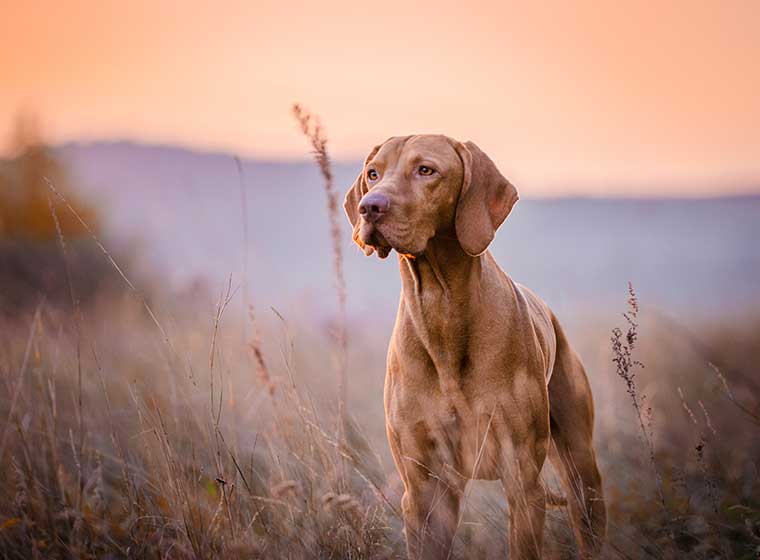
Magyar Vizsla – one of the oldest hunting dogs in the world. The ancestors of this dog came into the Carpathian Basin with the nomadic Hungarian tribes.
The Hungarian or Magyar Vizsla are sporting dogs and loyal companions. The Vizsla’s medium size is one of the breed’s most appealing characteristics. As a hunter of fowl and upland game, the Vizsla has held a prominent position among sporting dogs – that of household companion and the family dog.
The Vizsla is a natural hunter endowed with an excellent nose and outstanding trainability. It was bred to work in fields, forests or bodies of water. Although they are lively, gentle-mannered, demonstrably affectionate and sensitive, they are also fearless and possess a well-developed protective instinct.
Appearance:
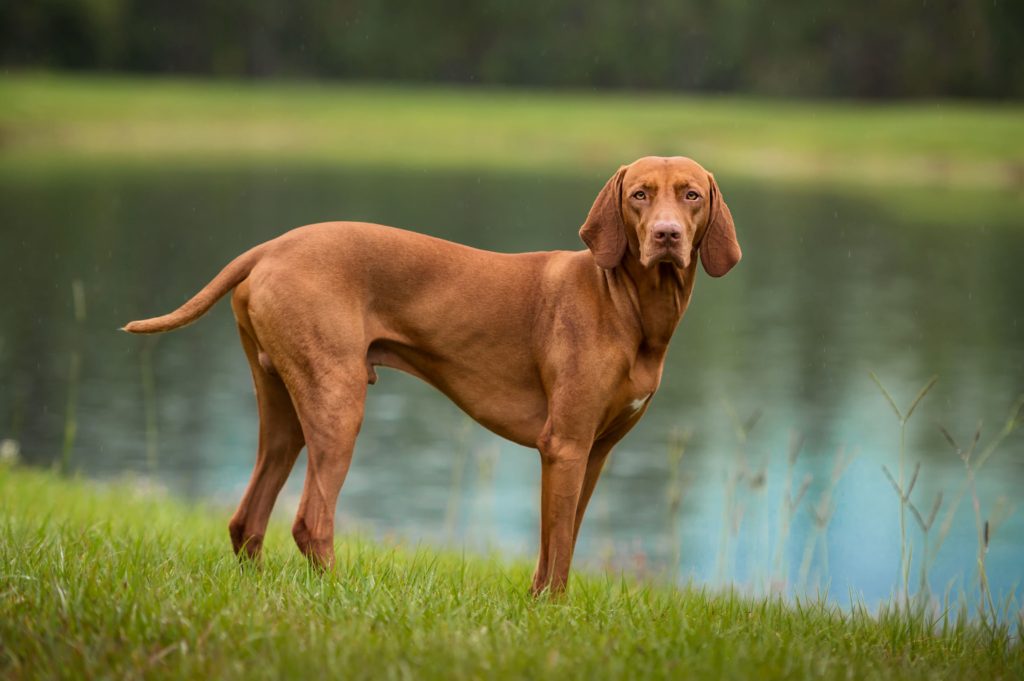
The Vizsla is a short-coated hunting dog of distinguished appearance and bearing. Robust, but rather lightly built, they are lean dogs that have defined muscles.
Various breeds are often mistaken for Vizslas and vice versa are commonly mistaken for other breeds. Redbone Coonhounds, Weimaraners and Rhodesian Ridgebacks are most commonly mixed up. The body structure of a Vizsla is very similar in appearance to a Weimaraner and a Redbone Coonhound, though the Vizsla is typically leaner with a more defined musculature. However, Weimaraners and Rhodesian Ridgebacks are larger than Vizslas.
The nose of the Vizsla will always have a reddish colour that blends with the coat colour. Black, brown, light pink, or another colour nose is an indication of another breed. A Vizsla’s eye and nail colour should also blend with the coat colour.
History:
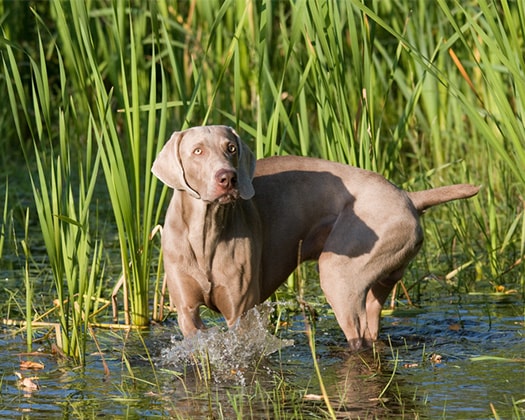
The first written reference to the Vizsla dog breed has been recorded in the Illustrated Vienna Chronicle prepared on order of King Louis I of Hungary by the Carmelite Friars in 1357.
As companions of the early warlords and barons, Vizsla blood was preserved pure for centuries by the land-owning aristocracy who guarded them jealously and continued to develop the hunting ability of these “yellow-pointers”. Records of letters and writings show the high esteem in which the Vizsla was held.
The Vizsla has survived the Turkish occupation (1526–1696), the Hungarian Revolution of 1848, World War I, World War II and the Hungarian People’s Republic. However, Vizslas faced and survived several near-extinction in their history, including being overrun by English Pointers and German Shorthaired Pointers in the 1800s (Boggs, 2000:19) and again to near-extinction after World War II. A careful search of Hungary and a poll of Hungarian sportsmen revealed only about a dozen Vizslas of the true type still alive in the country. From that minimum stock, the breed rose to prominence once again. The various “strains” of the Vizsla have become somewhat distinctive as individuals bred stock that suited their hunting style. Outside Hungary, vizslas are commonly bred in Romania, Austria, Slovakia, and Serbia.
The Vizsla started arriving in the United States at the close of World War II. As interest in and devotion to the breed began to increase, owners formed the Vizsla Club of America to gain AKC recognition. As a result of registering foundation stock with the AKC, Vizsla owners were able to obtain official recognition on 25 November 1960, as the Vizsla became the 115th breed recognized by the American Kennel Club.
The Vizsla was used in the development of other breeds, most notably the Weimaraner, Wirehaired Vizsla and German Shorthaired Pointer breeds. There is much conjecture about those same breeds, along with other pointer breeds, being used to reestablish the Vizsla breed at the end of the 19th century.
2. Hungarian Puli – small shepherd dog
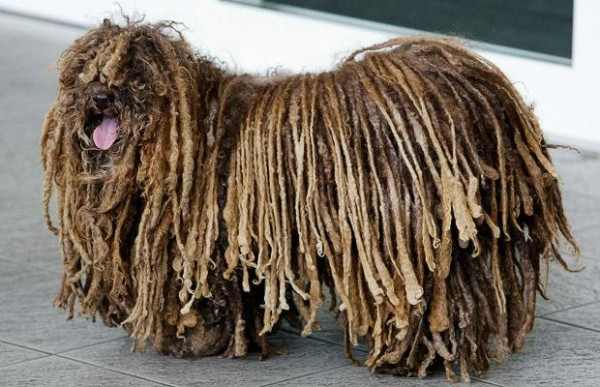
The Puli is a small-medium breed of Hungarian herding and livestock guarding dog known for its long, corded coat. The tight curls of the coat appear similar to dreadlocks. A similar-looking, but much larger breed – also Hungarian – is the Komondor. The term used for a group of Puli is Pulik.
History:
The Puli is a sheepdog from Hungary thought to be introduced by the migration of the Magyars from Central Asia more than 1,000 years ago. The Pulis were used for both herding and guarding livestock. The Puli would commonly work together with the much larger, white Komondor, a Hungarian breed of (solely) livestock guardian dog. The Komondor is a large, solidly built dog, around 30 inches tall. The Komondor (or several Komondorok if there was a large amount of livestock) guarded the sheep or cattle mostly at night, while the Puli herded and guarded them during the day.
When wolves or bears attacked the livestock, the Puli would alert the pack and the Komondorok would come and fight the intruders. Pulis can be good at fighting off wolves because the thick coat protects their skin from being bitten. The Komondorok usually rested during daytime but at night walked around the flock, constantly moving, patrolling the area.
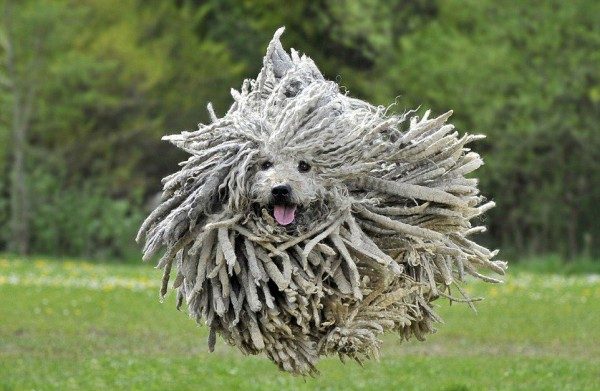
Nomadic shepherds of the Hungarian plains valued their herding dogs, paying as much as a year’s salary for a Puli.
Although the coats may look slightly similar, the Puli has never worked in water and the Puli’s coat does not grow continuously in the same fashion as a corded Poodle‘s coat once the cords are formed.
Possibly the Puli’s ancestors are ancient Hungarian shepherd dogs. Travellers brought the Puli with them to the Carpathian basin, to help organize the flocks and herd the stallions of the area. Large Komondor or Kuvasz was used for guarding the flock. The Puli was also a suitable guard for flock protection but was primarily used for herding the animals. Around the beginning of the 20th century, a real turning point for the breed came when it was rediscovered but no longer used much as a sheepdog; extensive shepherding was replaced by intensive farming. The Puli’s role was reduced in the life of the flock. Although their traditional duty was kept, they started to fulfil jobs that were convenient in the circumstances of their owner: they became house dogs. After World War II, the breed became a less popular pet; even now, the breed has not been able to regain the popularity it previously enjoyed.
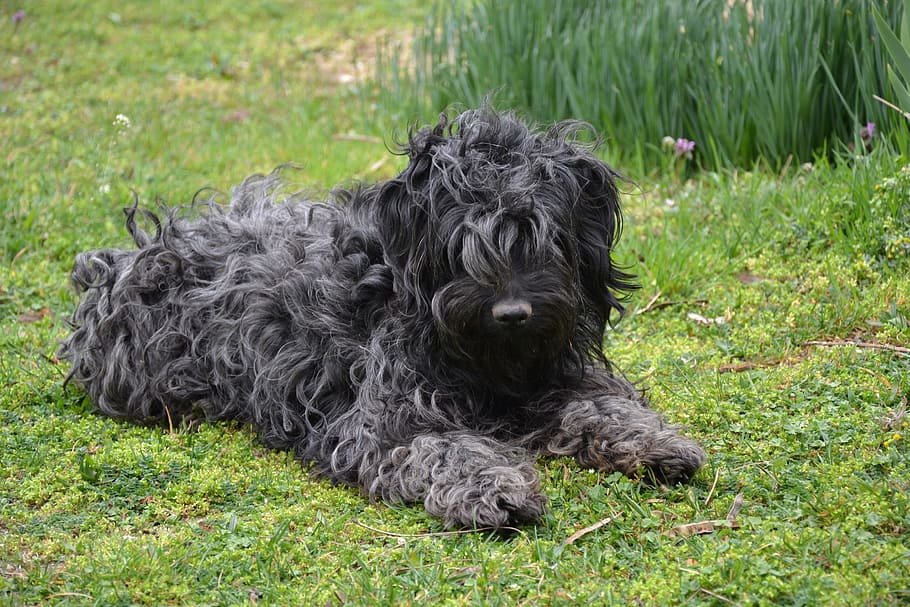
The U.S. Department of Agriculture imported four purebred Pulik in 1935 to Beltsville, Maryland as part of an experiment when trying to help American agriculturists concerned with the problem of herding dogs which sometimes killed the animals to which they had been entrusted to control. The Pulik were bred among themselves and crossed with the German Shepherd, the Chow Chow and perhaps with two Turkish sheepdogs which were quartered there at the time. On the tests given by researchers there, Pulik scored, on the average, between 75 and 85, where other herding breeds, scored in the range of 12 to 14. Because tests were inconclusive, they were never published. When WWII broke out, the Pulik were auctioned off to professional breeders, and, it is thought that it is from these four dogs and their progeny that history of the Puli in the United States began. Read More…
3. Hungarian Komondor
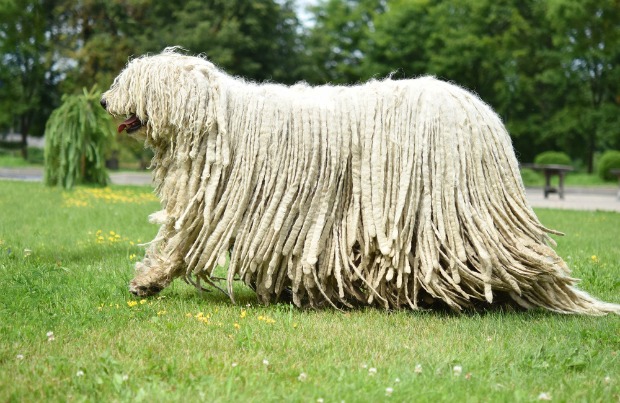
Hungarian Komondor – a very large livestock guardian and shepherd dog, was brought to Hungary a thousand years ago by nomadic Magyars.
The Komondor (in Hungarian, the plural form of komondor is komondorok), also known as the Hungarian sheepdog, is a large, white-coloured Hungarian breed of livestock guardian dog with a long, corded coat.
Sometimes referred to as ‘mop dogs’, the Komondor is a long-established dog breed commonly employed to guard livestock and other property. The Komondor was brought to Europe by the Cumans and the oldest known mention of it is in a Hungarian codex from 1544. The Komondor breed has been declared one of Hungary’s national treasures, to be preserved and protected from modification.
Etymology and history
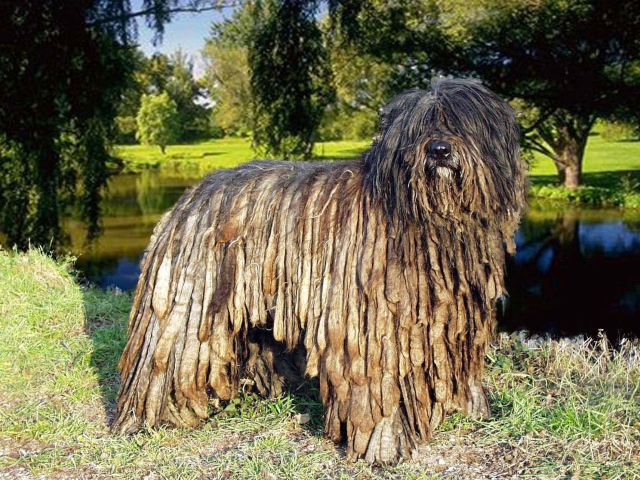
Komondorok were brought to Hungary by Cumans, the Turkic speaking, nomadic people who settled in Hungary during the 12th and 13th century. The name Komondor derives from Koman-dor, meaning “Cuman dog”. The breed descends from Tibetan dogs and came from Asia with the Cumans, whose homeland might have been near the Yellow River. In the late 10th century, Mongols began to expand their territories at the expense of the Cumans, forcing them to move westwards. Fleeing from the Mongols, they reached the borders of Hungary in the 12th centuries. Cumans were granted asylum and settled in Hungary in 1239 under Köten Khan. Komondor remains have been found in Cuman gravesites. The name “quman-dur” means “belonging to the Cumans” or “the dog of the Cumans”, thus distinguishing it from a similar Hungarian sheepdog breed which later merged with the Komondor. The name Komondor is found for the first time written in 1544 in the History of King Astiagis by Kákonyi Péter, in Hungarian. Later, in 1673, Amos Comenius mentions the Komondor in one of his works. Today, the Komondor is a fairly common breed in Hungary, it’s country of origin. Many Komondors were killed during World War II and local stories say that this was because when the Germans (and then the Russians) invaded, they had to kill the dog before they could capture a farm or house that is guarded.
The Komondor is a large dog. Young male Komondor, just over 12 months old, no proper cords developed yet
Young Komondor cords beginning to develop.
The Komondor is related to the South Russian Ovcharka, the Puli and, by extension, the Pumi, the Mudi, the Polish Lowland Sheepdog, the Schapendoes, the Bearded Collie, and the Old English sheepdog. In 1947, the Komondor was used to acquire fresh blood in the rare South Russian Ovcharka. In the 1970s, another Komondor cross was made. It is also believed to be related to the Briard, the Catalonian Sheepdog, the Cão da Serra de Aires, the Pyrenean Shepherd and the Bergamasco shepherd, but the Bergamasco has flocks, unlike the Komondor.
The two Hungarian breeds of livestock guardian dogs have evolved independently. This is because the Komondor was developed by a race of people who called it the Kuman-dor, the dog of the Cumans, and the Kuvasz was bred by a different people – the Magyars. For much of Hungary’s early history, these two peoples lived in separate areas in Hungary, spoke different languages and so did not mix. As a result, their dogs have little, if any at all, admixture.
Appearance:
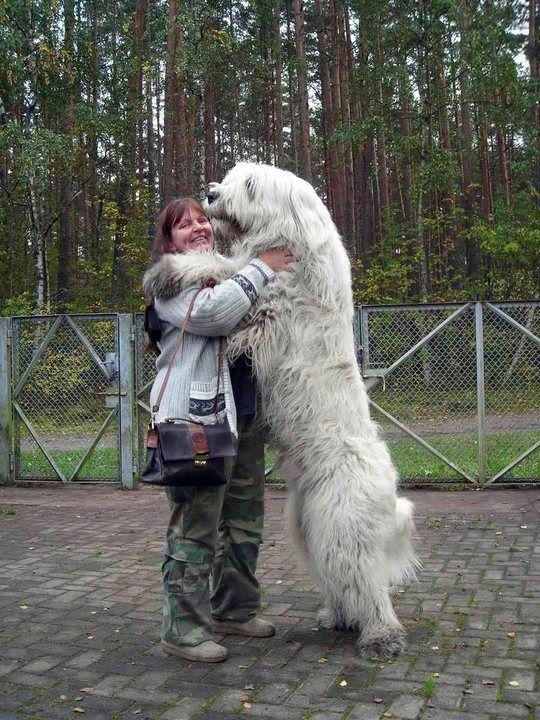
The Komondor’s coat is the long, thick, and strikingly corded white coat, about 20 – 27 cm long (the heaviest amount of fur in the canine world), which resembles dreadlocks or a mop. The puppy coat is soft and fluffy. However, the coat is wavy and tends to curl as the puppy matures. A fully mature coat is formed naturally from the soft undercoat and the coarser outer coat combining to form tassels or cords and will take about two years to form. Some help is needed in separating the cords so the dog does not turn into one large matted mess. The length of the cords increases with time as the coat grows. Moulting is minimal with this breed, contrary to what one might think (once cords are fully formed). The only substantial shedding occurs as a puppy before the dreadlocks fully form. The Komondor is born with only a white coat, unlike the similar-looking Puli, which can be white, black, or sometimes greyish. However, a working Komondor’s coat may be discoloured by the elements and may appear off-white if not washed regularly. Traditionally, the coat protects the Komondor from possible wolves’ bites as the bites would not penetrate the thick coat. The coat of the Komondor takes about two and a half days to dry after a bath.
4. Hungarian Kuvasz
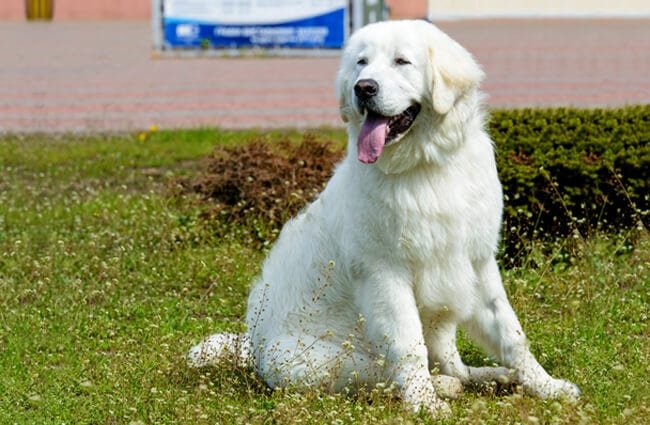
Hungarian Kuvasz – large shepherd dog.
The Kuvasz is a large dog with a dense, double, odourless coat which is white in colour and can range from wavy to straight in texture. Although the fur is white, the Kuvasz’s skin pigmentation should be dark and the nose is usually black. The eyes should have an almond shape. Females usually weigh between 32–41 kg (70–90 pounds) while males weigh between 45–52 kg (100–115 pounds) with a medium bone structure. The head should be half as wide as it is long with the eyes set slightly below the plane of the muzzle. The stop (where the muzzle raises to the crown of the head) should be defined but not abrupt. The precise standard varies by country. (See the Breed Standards for a more precise description.) To a casual observer, the Kuvasz may appear similar to a Great Pyrenees, Akbash, a Maremma Sheepdog, Slovak Cuvac and the Polish Tatra Sheepdog, all of which are similar in size, coat colour, and general appearance.
A Kuvasz puppy.
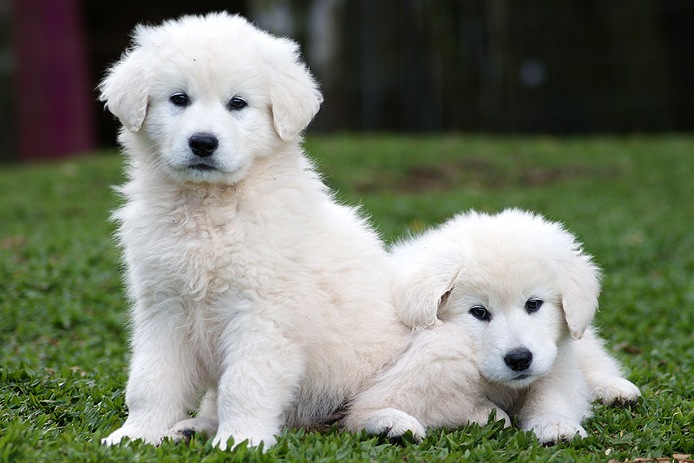
As with many livestock guardian dogs, the colour of the Kuvasz’s coat serves a functional purpose and is an essential breed criterion. Shepherds purposefully bred the Kuvasz to have a light-coloured coat so that it would be easier for the shepherds to distinguish the Kuvasz from wolves that would prey on the livestock during the night. The Komondor, a cousin of the Kuvasz, has a white coat for the same reason. Traditionally, the Hungarian Kuvasz’s coat could be either white or cream-coloured with a wavy texture. However, there is some debate, particularly in the United States, concerning the appropriateness of “cream” coloured coats in show-quality dogs and whether the coat should be straight or wavy in texture. Since washing and brushing out a coat, as done for shows in the US also causes the coat to appear straight, the debate may be circular. Straighter coats may also have appeared as the result of breeding programs that developed after World War II when the breeding lines in Hungary were isolated from the rest of the world as a result of Soviet & German occupation. By Hungarian standard, the straight coat is not acceptable. There must be special twirls in the coat.
History:
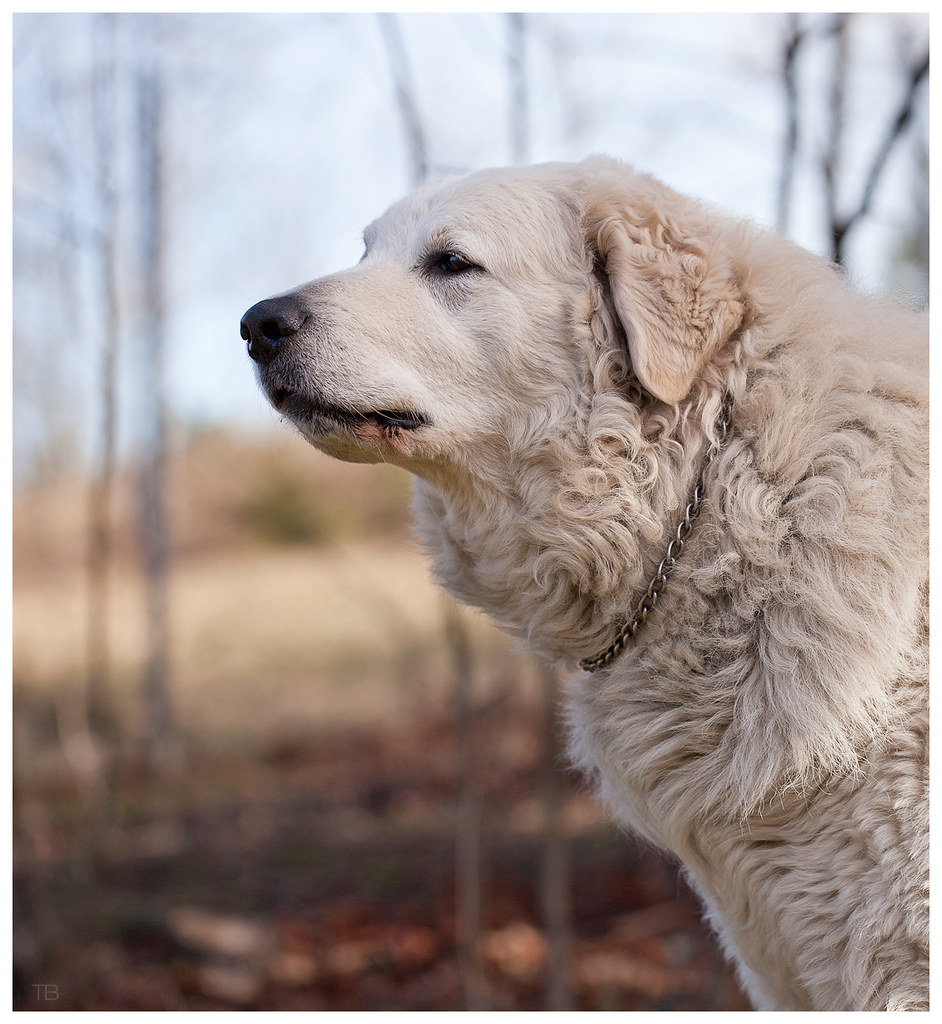
Around 2000 BC, the Magyar tribes moved along the recently established trade routes of the steppes, gradually leading them to the Carpathian Basin in Hungary which they conquered in 896 A.D. With them came Kuvasz-type dogs, which primarily served as livestock guardians. In 1978, the fossilized skeleton of a 9th Century Kuvasz-type dog was discovered in Fenékpuszta near Keszthely, a discovery which was remarkable in that the morphology of the skeleton was almost identical to a modern Kuvasz.
After the Magyar settlement of the Carpathian Basin, the tribes converted to a more agrarian lifestyle and began to devote more resources towards animal husbandry. Whereas the Komondor was used in the lower elevations with drier climates, the Kuvasz was used in the wet pastures of the higher mountains and both were an integral part of the economy. Later, during the 15th Century, the Kuvasz became a highly prized animal and could be found in the royal court of King Matthias Corvinus. Kuvasz puppies were given to visiting dignitaries as a royal gift, and the King was said to have trusted his dogs more than his own councillors. After the king’s death, the popularity of the breed among the nobles wanted but it was still frequently found in its traditional role of protecting livestock.
By the end of World War II, nearly all the Kuvasz dogs in Hungary had been killed. The dogs had such a reputation for protecting their families that they were actively sought and killed by German and Soviet soldiers, while at the same time some German officers used to take Kuvasz dogs home with them. After the Soviet invasion and the end of the war, the breed was nearly extinct in Hungary. After the war, it was revealed that fewer than thirty Kuvasz were left in Hungary and some sources indicate the number may have been as few as twelve. Since then, due to many dedicated breeders, Kuvasz breed has repopulated Hungary. However, as a result of this near extinction, the genetic pool available to breeders was severely restricted and there is conjecture that some may have used other breeds, such as the Great Pyrenees, to continue their programs. The issue is further clouded by the need to use an open stud book system at the time to rebuild the breed.
5. Hungarian Pumi
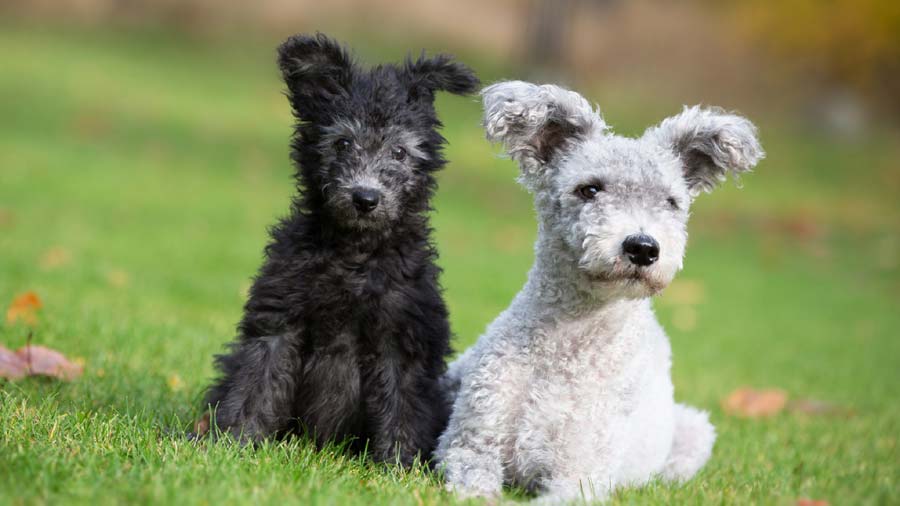
Hungarian Pumi – small shepherd dog.
The Pumi (in Hungarian, the plural form is pumik) is a medium-small breed of sheepdog from Hungary. They are versatile stock dogs equally adept at gathering, driving and keeping stock under control. They have a long head with semi-erect ears, a whimsical expression, and a tail that forms a circle over the back. The coat (black, white, grey, or fawn) is a combination of wavy and curly hair forming curls all over the body.
The Pumi is considered to have arisen from the cross-breeding of Hungarian Pulik with French and German herding dogs from the 17th century onwards. The international breed standard was approved in 1935. The Pumi became an officially recognised breed in the US in 2011 and in the UK in 2015. There are over 2,000 Pumis registered in Hungary, with notable populations in Finland and Sweden and small but growing numbers of registrations in the US, UK and Germany.
Some refer to the Pumi as the “Hungarian herding terrier” because it has some terrier-like attributes such as quick movement, alert temperament, and a quadratic, lean and muscular body type.
Appearance
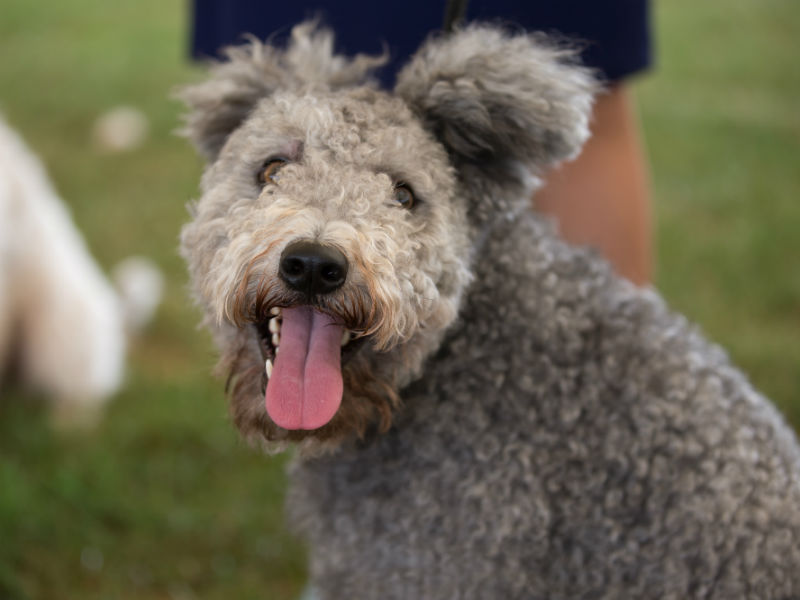
Pumis can be in varying shades of grey, white, or fawn (known as ‘fako’ in Hungary). Grey Pumis are the most common, born black, and ranging from almost black to light grey in adulthood. Puppies usually start greying at six to eight weeks old and the shade progressively lightens. The final shade is predicted by the colour of the parents. Other accepted colours are black, white, and cream to red with a darker mask, known as fawn with the mask. An analysis of 1023 Pumi puppies carried out in 2009 by the University of Debrecen found that 56% were born black turning grey, 14% were black, 13% white, 11% grey, and 4% are fawn-coloured. Brown, mottled or blue-merle-coloured puppies are born occasionally.
The thick coat is curly and of medium length, approximately 4-7 cm (1.5-3 inches) long and consisting of a harsh topcoat and soft undercoat, which provides good insulation and enables the dog to tolerate extremes of weather. The coat is maintained by combing every few weeks and trimming every two to four months. The coat grows constantly (similar to that of the Poodle) and, if grooming is not maintained, it may start matting. The breed has little to no shedding. The Pumi is known for its alert and lively ears, which are high-set and carried semi-erect and with longer hair than the body.
The Pumi is a square, light-bodied dog which looks somewhat larger because of its thick coat with a long, narrow head. The muzzle is 45% of the length of the head, which is of equal length to the neck. The stop is barely noticeable, and the skull is flat when seen from the side. The eyes are small, dark, and slightly oblique. Movements are lively and energetic as is the Pumi itself.
Male Pumis stand 41 to 47 cm (16 to 19 in) at the withers and weigh 10 to 15 kg (22 to 33 lb); bitches are 38 to 44 cm (15 to 17 in) and weigh 8 to 13 kg (18 to 29 lb).
History
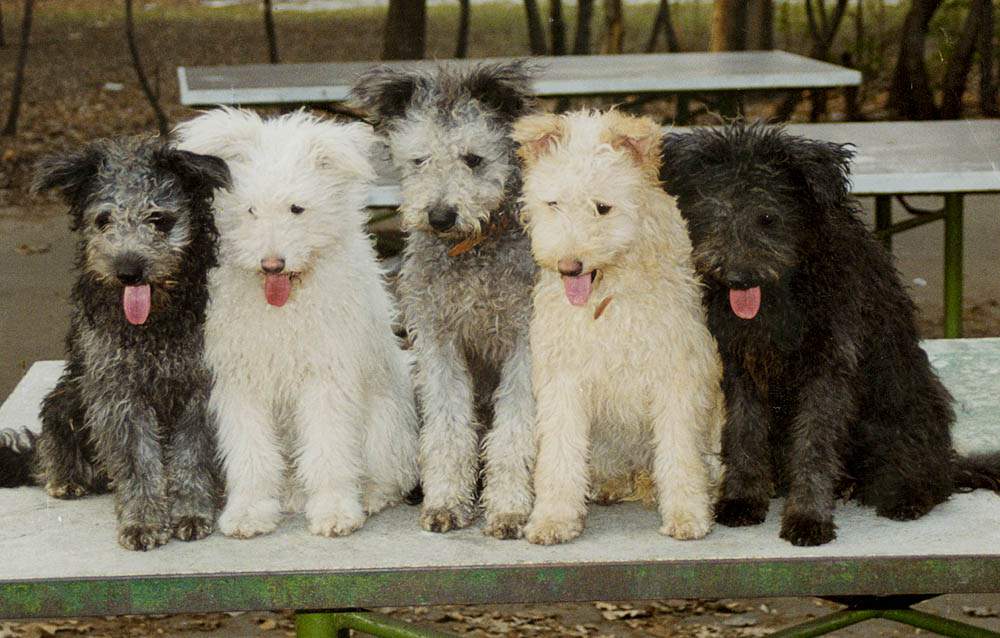
The breed is closely related to the longer-haired Puli. It is a sheepdog from Hungary that is thought to have been introduced by the migration of the Magyars from Central Asia more than 1,000 years ago. It can probably be traced back to Tsang Apso (Tibetan Terrier). The ancestral Hungarian herding dog appears to have been brought west during the migration from the Ural-Altay regions around 800 AD. The Pumi arose from later cross-breeding with French and German sheepdogs, such as the Spitz and Briard.
The breed evolved spontaneously and was not the result of planned breeding. Pulis was cross-bred with German Pomeranians, French Briards, and several varieties of terriers during the 17th and 18th century. In the 18th century, many Merino sheep were imported to Hungary, along with small Pyrenean Mountain Dogs that probably contributed to the development of the Pumi producing dogs with a shorter and curlier coat. The first known drawing of a Pumi is from 1815.
The breeding of pedigree dogs began on the initiative of Count István Széchenyi, founder of the Hungarian Academy of Science. Within the Austro-Hungarian empire, during the later part of the 19th century, breeding of native Hungarian dogs was not encouraged. During the early twentieth century, Hungarians separated their herding dogs into the various breeds according to their phenotypes, and so the first distinction between Puli and Pumi was published in 1902. The Puli was most common on the east Hungarian plains the Pumi in the hills of West Hungary with the Mudi common in southern Hungary. In the 1910s, controlled breeding began, but many large herds and their dogs were lost during the First World War and the subsequent division of Hungary.
Dr Emil Raitsits who created the Pumi breed standard in 1921, referred to it as a “sheepdog terrier”. Numbers rose between the wars with 130 of the dogs registered in 1924 when they were seen in the show ring and as working dogs. Raitsits was keen to preserve its typical terrier qualities. Before 1923, Pumis had been shown as local varieties of Pulis, but, by 1927, the two breeds had been officially separated. The Pumi standard was approved by the FCI in 1935 along with the scientific name Canis familiaris ovilis villosus terrarius-Raitsitsi. This had been proposed by Csaba Anghi to reflect the great deal of terrier in the Pumi both in its features and character. The early breed standards focused on the differences between the related breeds noting for the Pumi with its distinctive features such as a longer muzzle, smoother stop line, upright folding ears, and its non-corded coat.
During the Second World War, food shortages and lack of veterinary care reduced their numbers again and many dogs were shot by soldiers. Ria Hörter wrote that “Ilona Orlay, one of Dr Raitsits’s assistants, walked through a burning Budapest pushing a chart [sic, ?cart] containing valuable Hungarian sheepdog papers, from the office of the Hungarian Kennel Club to a place of safety.”
Breeding became possible again in the period after the 1956 uprising. The 1960 breed standard, which remained current through to the 1980s, allowed any solid coat colour, but the variations seen within the breed during the 1950s had since been reduced. It was first exported to Finland in 1973 and Sweden in 1985 and then to Italy and the Netherlands and the US in the early 1990s. The current international breed standard dates from September 2000. In 2016, the Hungarian government named the Pumi as one of its eight indigenous dog breeds, created a gene bank to preserve its characteristics, and announced support for breeding at the Hungarian national breeding centres.
6. Hungarian Sighthound
Hungarian Sighthound – already known in the 8th century, it is as old as the Vizsla.
7. Magyar agár

The Magyar agár (MA) is a dog breed. It is a type of sighthound originating in Hungary and lands that previously belonged to the Austro-Hungarian Empire (such as Transylvania). It is used for hunting and coursing and is also kept as a companion.
Although the Magyar agár is also called the ‘Hungarian greyhound’ this is a misnomer. The Magyar Agár is a distinct breed with its breed designation and unique characteristics. A more proper alternative name would be Hungarian gazehound or Hungarian sighthound.

The Magyar agár is a sighthound of elegant yet rugged stature. While they bear some resemblance to Greyhounds, there are several significant differences in conformation between the two breeds. Magyar agárs are longer in the body than they are tall, and have a heavier bone structure than Greyhounds. Their heads are more wedge-shaped, with substantial jaw muscles and shorter snouts, giving them a less refined appearance than most Greyhounds. They also have much thicker skin with a short, dense and smooth coat that is slightly longer during winter months. As such, they are very hardy dogs and can tolerate lower temperatures better than some of the other short-coated sighthounds. They have rose-shaped ears that are raised about halfway and oval-shaped eyes with a bright and gentle looking expression. They weigh between 49 pounds (22 kg) and 68 pounds (31 kg) with a height between 25 inches (64 cm) and 27 inches (69 cm) at the shoulders. They come in a variety of colours. The amount of “greyhounds” in the MA is the point of controversy among European breeders and enthusiasts. This issue revolves around the fact that greyhounds were bred with MAs in the 19th century and early 20th century. Some prefer an “old fashioned” variation of the MA with its robust frame and musculature, while some prefer a more “greyhound-like” dog with a lighter frame and more speed.
The sturdy frame of the Magyar agár makes it ideal for coursing game over rugged terrain. Given their conformation, Magyar agár is not as fast as Greyhounds on short sprints, but possess greater endurance and stamina, making them much more suited to running longer distances for longer periods. In the old days, these dogs would have been expected to trail alongside their masters on horseback.
The Magyar agár has an average life span of 12–14 years.
History:

These dogs probably accompanied the Magyars to the Carpathian Basin and Transylvania in the 10th century. Tradition tells us that the Magyar agár first arrived in northeastern Hungary and the Great Alföld (Hungarian Plain) a little over a thousand years ago. The earliest archaeological evidence for the Magyar agárs has been found in the Carpathian Mountains along the northern and eastern border of Hungary. Currently, it is not known whether the Magyar agárs existed before the Magyars reached the Carpathian basin.
Although they have lived throughout the Great Alföld, they have had a strong hunting history in the three counties of Szabolcs-Szatmár-Bereg, Hajdú-Bihar and Somogy. The confirmation of the Magyar agár has remained the same from the Medieval to the Modern Age until the introduction of the greyhound in the 19th century.
The Magyar agár was bred for long-distance racing: dispatching hare or deer shot by horseback riders in an open field or open stand of forest. Hungarians claim that the MA was expected to run along with the hunters for distances of 30 kilometres (19 mi) to 50 kilometres (31 mi) per day. Through most of Hungarian history, the Magyar agár was not restricted to the nobility, although the MA owned by the nobility were much bigger than the others. “Magyar Agárs owned by the peasants were known as Farm Agárs or simply as Hare Catchers. These smaller versions of the MA are now extinct.”
8. Transylvanian Bloodhound
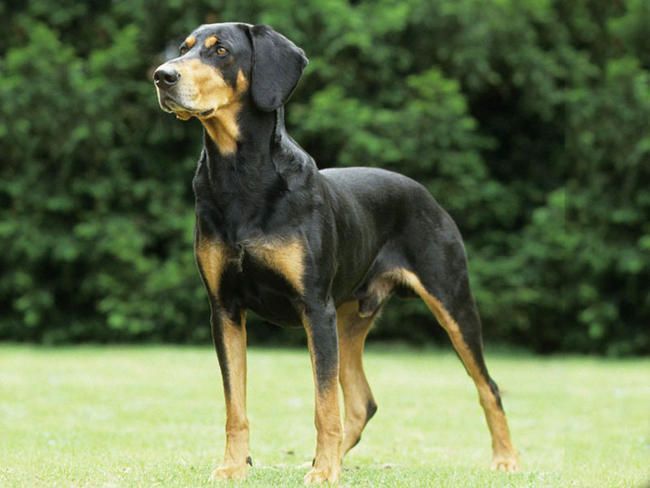
Transylvanian Bloodhound – a hunting dog.
The Transylvanian Hound (Hungarian: erdélyi kopó, also known as the Transylvanian Scent Hound or Hungarian Hound) is a dog breed from the Kingdom of Hungary, Transylvania (found today in Hungary and Romania), historically primarily used for hunting. It is a strong, medium-sized scent hound, characterized by a black body, with tan and sometimes white markings on the muzzle, chest and extremities, and distinctive tan eyebrow spots. It has a high-pitched bark for a dog of its size. The breed was rescued from extinction by focused breeding efforts in the late 20th century. There were formerly two varieties, the tall and the short, developed for different kinds of hunting in the Middle Ages. Only the tall variety survives today. Read More…
History:
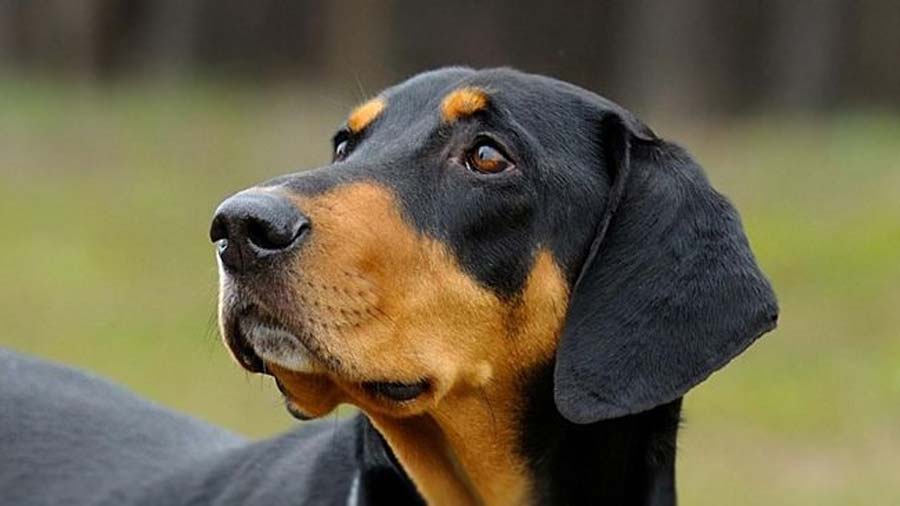
The dog was the favourite of the Hungarian aristocracy during the breed’s peak in the Middle Ages, for hunting various game animals Two height varieties developed to hunt different game in different types of terrain, and both varieties were kept together. The tall variety was used for hunting woodland and grassland big game, such as European bison, bear, boar, and lynx. The short variety was used for hunting fox, hare, and chamois in overgrown or rocky terrain.
The breed declined and was marginalised to the Carpathian woodlands, shrinking with the growth of agriculture and forestry. At the beginning of the twentieth century, the breed was nearly extinct, and not recognised and standardised by the Fédération Cynologique Internationale (FCI) until 1963. In 1968, efforts began to save it. Today, a substantial number of the tall variety of the dogs may be found in both Hungary and neighbouring Romania. However, only the tall variety remains today.
The Transylvanian Hound is, naturally, recognised by the national dog breeding and fancier group, the Hungarian Kennel Club (using the FCI breed standard). The breed was recognised with a breed standard by one US-based group, the United Kennel Club (UKC), in 2006. The more prominent American Kennel Club publishes no standard for it, though the organisation at least provisionally recognises its existence, announcing its acceptance in 2015 into the AKC Foundation Stock Service Program, for breeders hoping to establish it in the United States. Read More…
9. Hungarian Mudi
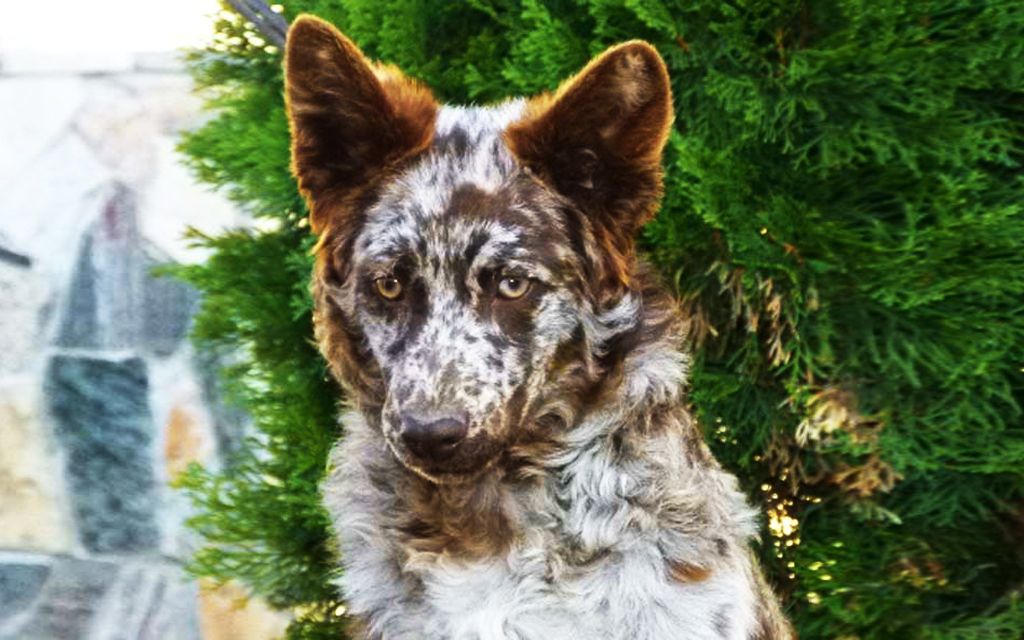
Hungarian Mudi – small shepherd dog.
The Mudi (in Hungarian, the plural form of mudi is mudik) is a herding dog breed from Hungary. It is closely related to the Puli and Pumi, from which it was separated in the 1930s. Today, the Mudi is bred for work, sport, companionship, and show. They continue to be used in herding, as well as participating in a variety of dog sports. They are often said to be the “barkiest dog breed” and are not recommended for the typical dog owner.
History
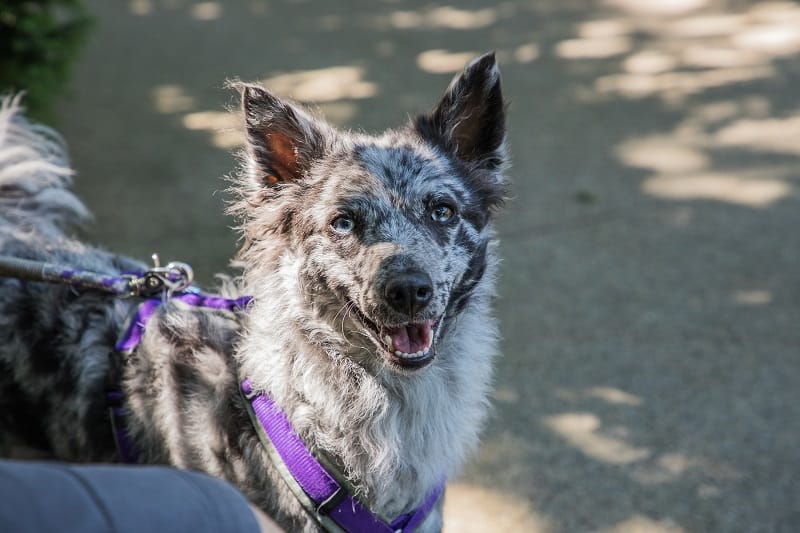
The Mudi was first discovered as a breed in 1936 by Dr. Dezso Fenyes in Hungary, where it became known as the “driver dog.” Mudis nearly disappeared shortly after their recognition, as many were killed during World War II. The breed became recognized by The Federation Cynologique Internationale in 1966, followed by the United Kennel Club in 2006. In the American Kennel Club, Mudi is in the Miscellaneous Class. The Mudi still actively herds in Hungary with Hungarian shepherds and with flocks of up to 500 sheep.
Temperament
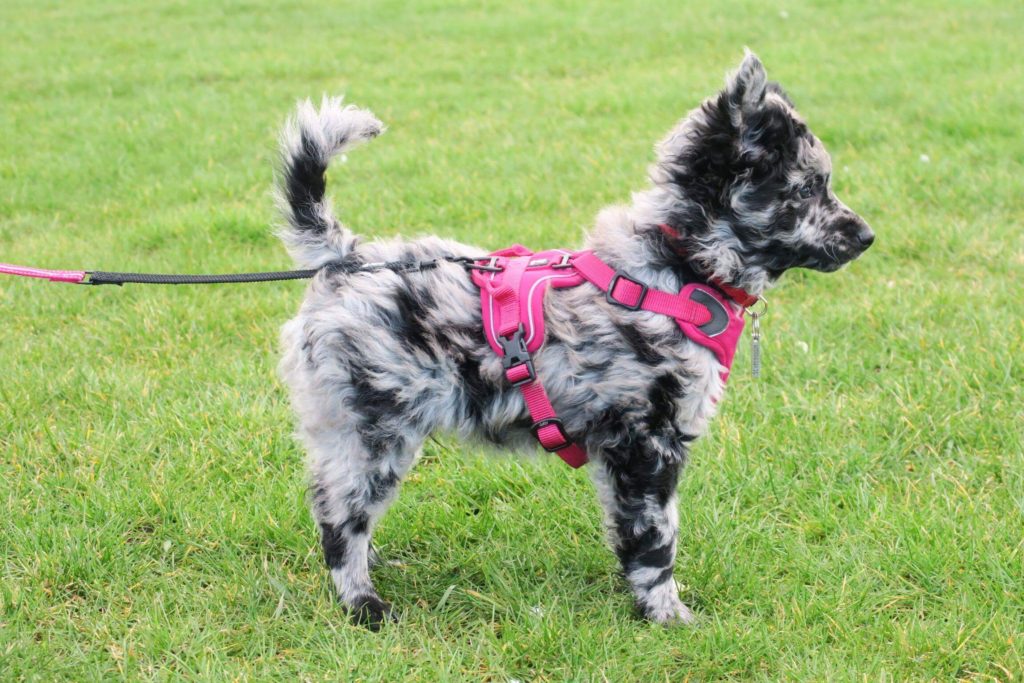
The Mudi is a versatile farm dog that can hunt, exterminate rodents, and act as a capable herding dog and flock guardian. They are great for alerting and protecting their home and family. They have a high pitched bark and are often very loud. There are three herding dogs native to Hungary: the Puli, Pumi and Mudi, all having similar characteristics. The Mudi is a clever, keen, active dog who becomes very attached to its owner and family. They are often aloof with strangers and early socialization is recommended. The Mudi is often talked about as being “the barkiest breed”. The Mudi is not recommended for the typical dog owner due to not only its high energy but also that many in the breed have temperament issues and struggle with fearfulness and reactivity.
10. Sinka
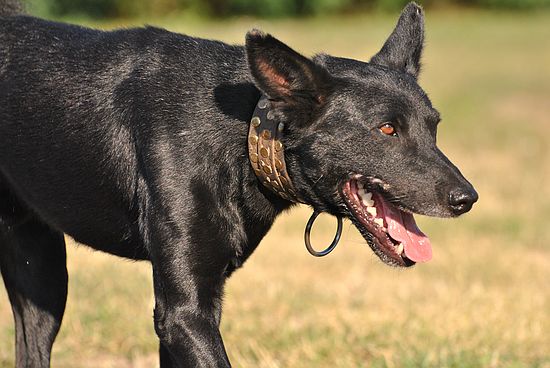
Sinka: The New’ Hungarian dog breed.
Sinka is a quite young family member of Hungarian dog breeds; it is the youngest, actually, reports 24.hu. The mixed-breed was ‘created’ at Hortobány (Hungarian lowland) from already mixed dogs and also boyers, German shepherds and some dogs with ‘bull’ in its name.
The population is around 1 – 2000. Shepherds think it is the ideal number for the population because it is not yet so popular that non-shepherds would choose them because of the dog’s looks. The Sinka is still strong and hard-working, yet human-loving dog, also like kuvasz, vizsla or puli.
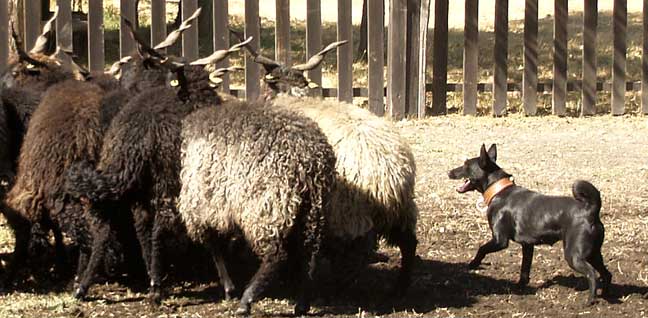
The name ‘Sinka’ is coming from Hungarian “sima szőrű” (smooth hair). A very easily teachable, agile and muscular dog with proportional body structure. They are working next to Hungarian grey cattle or sheep. The breed’s survival can be thanked shepherds for mating the dogs, but also the environment, they live in is what shaped their body and mentality. It quite resembles the Hungarian grey cattle’s hot-temperament and freezing Hungarian winters and hot summers shaped its aptitude to be fit and a good work-doggy.
Many people would mistake it with pumi, but since pumi has appeared earlier in the 17th century, it became more domestic over time. Both breeds are energetic, yet very friendly to people and his/her owner. For those, who wish to own a Sinka inside the house: no way, sorry. The dog is energetic, it requires big gardens and spaces and is not so domestic yet.